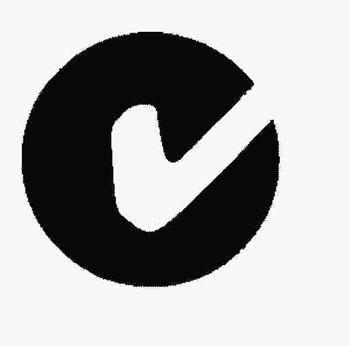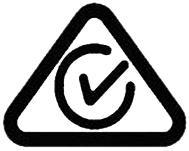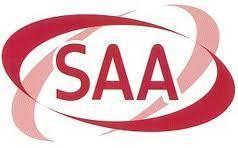C-Tick EMC Australia is part of the Australian Communications Authority (ACA - Australia Community Association) to control, only part of the interference of control, control of the product in 1999 from 1 / 01 to start enforcement.

<Electrical safety requirements>
In Australia, electrical safety assessment is in line with the local government. Each department in charge of unification "in 1945 Electrical Safety Law" mutual recognition (Approvals Scheme). This will be divided into electrical products, "Notice" (Declared) and "non-Notice" (Non-declared) two broad categories.
Notice of products subject to the relevant Australian safety standards and state authorities with a certificate.
Notice of non-electrical and electronic equipment without a direct sales certification. However, retailers, manufacturers and importers must ensure the safety of such appliances.
<EMC request>
EMC Australia on the framework for the adoption of EMC (1992 Radiocommunication Act) of the self-declared manner. In the framework of the norms of electrical products are subject to the standards of Australia and the Australian Communications Authority to obtain approval to use the C-Tick mark.
At the same time, if the products meet the electromagnetic compatibility and electrical safety requirements may also apply laws and regulations in line with the mark (RCM).
Australia was no sign of security products in New Zealand are to be recognized.
At present, Australia and New Zealand are the introduction of RCM signs of electrical products in order to achieve the reunification of the logo, which was marked by Australia and New Zealand regulators have trademarks, products that comply with security regulations at the same time, and EMC requirements of the non-mandatory.
RCM mark

RCM = Safety + EMC + Importer Declaration
1. Safety (product safety certification):
Product safety certification of two parts: electrical products are divided into categories of electrical control (Prescribed Product) and non-control products (Non-prescribed product).
1). Control AS/NZS4417.2 under the category of electrical products division, including electric equipment, refrigeration equipment, electric tools, parts and components, and so on. One of the three licensing unit in Queensland, New South Wales and Victoria states in the certification process is most active. Control-type electrical appliances must be made mandatory monitoring by the department issued with a certificate (Certificate of Approval), and provides identification (certificate must be marked No.) . Certificate, the first letter which revealed that the certificate issued by state or region. Such as:
(1) Q04051 (Queensland Queensland) --- Q Number
(2) W2015 (Western Australia Western Australia) --- W Number
(3) V03101 (Victoria Victoria) --- ESV Certificate V Number
(4) NSW18099 (New South Wales New South Wales) --- DOFT Certificate NSW Number
2). Non-electrical type of control need not be certified to sell directly, but manufacturers have to guarantee the safety of electrical products in line with Australian standards AS/NZS3820: 1998 (Essential Safety Requirements for Low Voltage Electrical Equipment); department will monitor the standard of the products presented in line with the requirements of Certificate (Certificate of Suitability). Obtain a certificate of compliance of electrical products can be marked with a certificate, a certificate of the final letter which revealed that the certificates issued by state or region, such as:
(1) CS/431/Q (Queensland)
(2) CS/108/NSW (New South Wales)
2 EMC (EMC)
Australia's electromagnetic compatibility with the plan is based on the 1992 Radio Communications Act (Radio Communications ACT 1992) formulated, covering a wide range of products, including motor-driven heat and electrical products, power tools and similar products, lighting and similar equipment, TV receivers and audio equipment, information technology products, industrial scientific instruments and medical equipment, fire engines and welding equipment. The products have a plan in accordance with the risk of electromagnetic interference, the product will be divided into three categories, the second and third categories of products must be accompanied by C-Tick mark. But no matter what type of product belongs to, must comply with all relevant EMC standards.
A class of products: the use of wireless spectrum the device is only slightly affected products, such as manual switches, relays simple, brushless-cage induction motor, AC power / power transformer, resistors and so on. Sales in the production of such products can apply for the voluntary use of C-Tick mark.
II: the use of wireless spectrum that are equipped with a greater impact on products such as microprocessors or even a digital clock devices, rectifiers, or slip-ring motors, welding equipment, switching power supply, light and electrical regulator Speed control, information technology (CISPR 22) categories of telecommunications terminal equipment (since November 7, 2003 starting from the third category be changed to the second category).
Three categories of products: the use of wireless spectrum that are equipped with a serious impact on products such as industrial, scientific instruments and medical equipment, Group 2 (CISPR11).
The RCM-related applications
(1) If the product differences between countries and CB there, you can go directly to Safety Certificate. EMC combined with some of the agents so that they can help out a declaration. The product can be marked for sale to Australia and RCM Mark.
(2) Safety Certificate: to apply for part of the safety, if the products are direct plug in, the need for products that do AU Plug Test (Test Standard: AS / NZS 3112: 2004), if products are Desktop, you do not need to do the testing .
(3) EMC Report --- that is, can be a C-Tick Report (Test Standard: AS / NZS CISPR 22: 2002), may also be CE EMC Report.
Australia's standards body for the Standards Association of Australian, so many friends in Australia to certification as the SAA certification. SAA is in fact the standard-setting bodies, and not issued a certificate authentication products. SAA later changed its name to: Standards Australia Limited. SAA is an independent company with no direct relationship between the government, but the federal government and state governments in which it is a member. SAA and Australia signed a memorandum of the federal government, SAA is the recognition of Australia's non-governmental organizations of the highest standards of the organization. Memorandum also pointed out that the standards should be in line with WTO requirements. As a result, there is an agreement that when the appropriate international standards already exist, they do not have to develop new standards for Australia. Australia's standards in order to "AS" at the beginning, Australia and New Zealand joint standard to "AS / NZS" at the beginning. Australia and New Zealand's standard of basic standards in line with the IEC and at the same time there are some differences between countries. Australia and New Zealand to implement uniform standards and mutual recognition of certification, as long as the products made of a country can be certified for sale in another country.

First, certification / supervision:
Australia is a federal country, electrical safety and power consumption requirements of the certification, control and management by the various states or regions to monitor the sector (Regulatory Authority) in accordance with state / regional accreditation procedures. Any certificate issued by the state in other states / territories.
Equally effective, do not have any additional procedures. In addition, SAA standard-setting bodies, a wholly owned subsidiary QAS (Quality Assurance Services Pty Ltd.) Australia is the NCB (National Certification Body), the certificates are issued to the various states or regions to recognize, has the same effect.
Second, product safety certification
Australia does not have a unified security certification mark, each state or region in order to have legislation in the form of provisions for the management of electrical products. Although the name and date of the enactment of different states or territories on all electrical safety legislation basically the same. Electrical products are divided into categories of electrical control (prescribed product) and non-control products (Non-prescribed product).
Control AS/NZS4417.2 under the category of electrical products division, including electric equipment, refrigeration equipment, electric tools, parts and components, and so on. Contents of the Government Gazette published, and in accordance with the actual increase in cases. Queensland, New South Wales and Victoria states in the certification process is most active. In Queensland, for example, the power law (the electricity Act 1994) announced the certification of electrical, sale and use of the detailed requirements.
1, the type of electrical control: control-type electrical appliances must be made mandatory monitoring by the department issued with a certificate (certificate of approval), and provides identification (certificate must be marked). It should be noted that the accreditation process, not only for safety or quality of the performance, unless the security-related. Certificate, the first letter which revealed that the certificate issued by state or region. Such as:
Q91610 (Queensland)
W2015 (Western Australia Western Australia)
N10422 (New South Wales New South Wales)
2, non-electrical type of control: control products is not mandatory to obtain certification, but its security by the seller / producer, may voluntarily apply for certification. Monitoring will be in line with departmental standards of product compliance certificate issued (Certificate of Suitability). Obtain a certificate of compliance of electrical products can be marked with a certificate, a certificate of good the last letter which revealed that the certificates issued by state or region, such as:
CS/431/Q (Queensland)
CS/108/N (New South Wales)
RCM signs: Australia and New Zealand are the introduction of RCM marks (Regulatory Compliance Mark), electrical products in order to achieve the reunification of the logo, which was marked by Australia and New Zealand regulators have trademarks, products that comply with security regulations at the same time, and EMC requirements of the non-mandatory . Products made in the safety certification and registration of electromagnetic compatibility, safety certification issued by the regulator or "RCM Registrar" (Standards Australia) to apply for the use of RCM mark.
SAIGLOBAL signs: by SAI (the original SAI) issued by the product safety signs, the signs of a non-mandatory, and the need to inspect factories and so on.
Third, the energy label
Although most of the states and territories with air-conditioning appliances and household energy consumption has a similar mandatory for all state compulsory product certification directory are not the same. At present, Queensland and Victoria, the most complete catalog. Any other state to register in the state and the region achieve the same purpose. Energy requirements apply to the following household electrical:
Refrigerator and cooler (test standards: AS / NZS 44741.1, AS / NZS 4474.2)
Washing machine (test standards: AS / NZS 2040.1, AS/NZS2040.2)
Clothes dryers (the standard test: AS/NZS2442.1, AS/NZS2442.2)
Dishwasher (test standards: AS / NZS 2007.1, AS/NZS2007.2)
One-way domestic air-conditioning (standard test: AS/NZS3823.1.1, AS/NZS3823.1.2, AS/NZS3823.2, AS/NZS3823.3) They are required to monitor the application form submitted to the agency with complete and accurate test reports Energy labels samples. The report must be tested by accredited laboratories issued since the date of issuance of three years effective.
Fourth, the electromagnetic safety requirements.
Electrical and electronic products to enter Australia, with the exception of the safety mark, EMC should have signs that c-tick mark. The purpose is to protect the radio frequency communication resources, which provided for the implementation of a system somewhat similar to the European EMC Directive. As a result, manufacturers can / importer to self-declaration. However, applications for C-tick mark before CISPR according to the relevant standards for testing. And to be endorsed by the Australia & importers to submit a report. Australia ACA (Australian Commication Authority) accept reunification, the registration number issued.
EMC in Australia by the ACA (Australian Communications Authority) control in Australia, EMC systems, products fall into three categories, the supplier for sale in the second, three types of products before the ACA must apply for registration using the C-TICK mark.
A class of products: the use of wireless spectrum interference devices with lower radiation products, such as manual switches, relays a simple, one-way squirrel-cage motor inductance, resistance and so on. Sales in the production of such products can apply for the voluntary use of c-tick mark.
II: the use of wireless spectrum interference radiation equipment higher products, such as switching power supply, electric welding, dimmers, most of the household appliances and so on.
Three categories of products: the use of wireless devices interfere with high frequency products, that is, CISPR11 and CISPR22 coverage. As the ACA application for registration in the use of C-TICK mark of the applicants are limited to Australia or New Zealand registered company, through Australia or New Zealand or the buyers in New Zealand or Australia by the branch / partner agencies to apply for certification.
Certification cycle.
6-7 weeks





